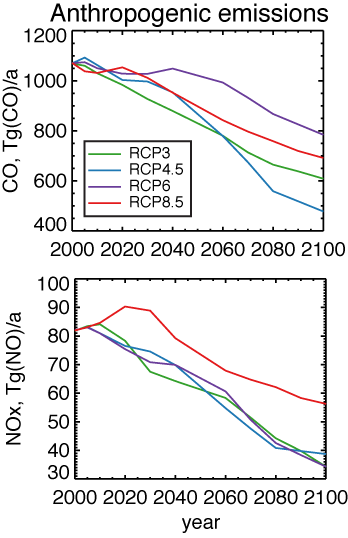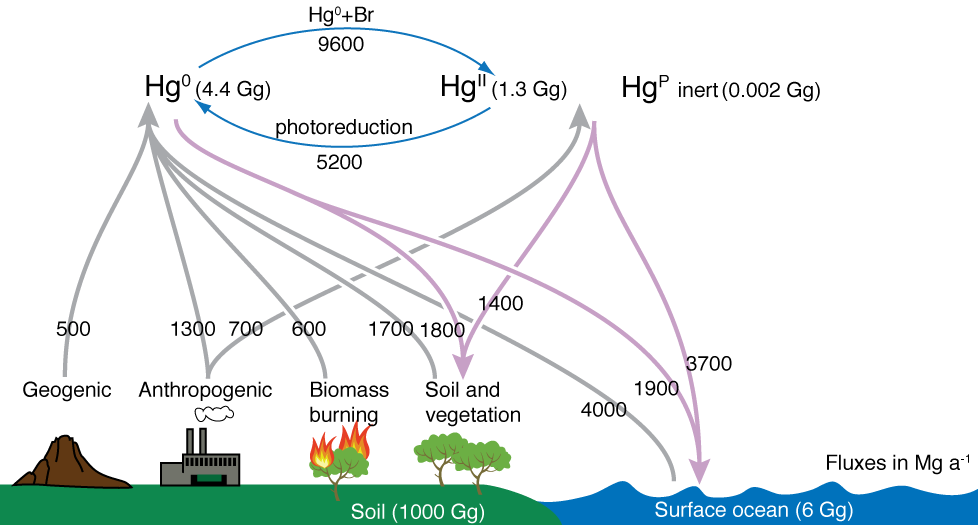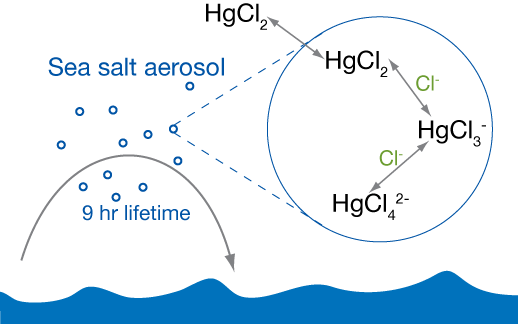Current research
Greenhouse gases / Mercury biogeochemistry / Atmospheric processesProjections of greenhouses gases, with uncertainty
Background: Climate models currently calculate future radiative forcing and climate change from greenhouse gas concentrations that are determined within each model. Since climate models use simplified atmospheric chemistry for computational efficiency, their inferred abundance of photochemically-active gases, such as methane and ozone, may not be consistent with our best understanding of their sources and sinks. Furthermore, because the simplified atmospheric chemistry is different in many climate models, the models will differ in their methane and ozone abundances, even when they use the same emission scenario. Objective: We are creating a simple parametric model to project methane and ozone abundances along any emission scenario through the 21st century. The model is derived from sensitivity tests with a small suite of global 3-D atmospheric chemistry and transport models (CTMs), including the UCI CTM and GEOS-Chem. The simplified model takes into account changes in the background NOx abundance, convection, and uncertainties due to interannual variability of winds, biomass burning, and lightning. |

Figure: Projected emissions of ozone precursors CO and NOx (NOx=NO+NO2) over the 21st century. |
For more information:
- Holmes, C. D., M. J. Prather, O. A. Søvde, and G. Myhre (2013) Future methane, hydroxyl, and their uncertainties: key climate and emission parameters for future predictions, Atmos. Chem. Phys. 13, 285-302, doi:10.5194/acp-13-285-2013.
- Prather, M. J., C. D. Holmes, and J. Hsu (2012) Reactive greenhouse gas scenarios: Systematic exploration of uncertainties and the role of atmospheric chemistry. Geophys. Res. Lett., doi:10.1029/2012GL051440.
- Holmes, C. D., Q. Tang, M. J. Prather (2011) Uncertainties in climate assessment for the case of aviation NO, Proc. Natl. Acad. Sci. 108, 10997-11002, doi:10.1073/pnas.1101458108.
Global fate and transport of mercury
| Background: The ultimate goal within this research area is to understand the fate of mercury in the environment and how it enters food webs. My Ph.D. dissertation work identified several poorly-understood processes that control this fate and, thus, will be my focus in the medium-term future. These include wet scavenging of soluble mercury, gas-particle partitioning, photoreduction of Hg(II) in air and snow, and rapid oxidation events in the upper troposphere and marine boundary layer. To address the wet scavenging issue, for example, I am adding mercury chemistry and scavenging to a cloud-resolving atmospheric model with detailed cloud microphysics. This modeling tool will enable us to explore the dynamical and chemical causes of mercury enhancements in thunderstorms, the regional enhancement of mercury deposition in the southeast US, and wet deposition data elsewhere. |
 Figure: Global atmospheric budget for mercury derived from the GEOS-Chem model (Holmes et al. 2010). |
For more information:
- Holmes, C. D., Jacob, D. J., Corbitt, E. S., Mao, J., Yang, X., Talbot, R., and Slemr, F.: Global atmospheric model for mercury including oxidation by bromine atoms, Atmos. Chem. Phys., 10, 12037-12057, doi:10.5194/acpd-10-12037-2010, 2010.
- Soerensen, A.L., E.M. Sunderland, C.D. Holmes, D.J. Jacob, R.M. Yantosca, H. Skov, J.H. Christensen, and R.P. Mason, An improved global model for air-sea exchange of mercury: High concentrations over the North Atlantic, Environ. Sci. Technol., 44, 8574-8580, 2010
Atmospheric process studies
Background: Simple models can provide insights into the atmospheric processes that are obscured within the complexity of global 3-D models. My work uses box models to interpret observations and refine our understanding of how mercury and trace gases are affected by gas-aerosol exchange, boundary layer dynamics, and photochemistry. Essential processes from the box models can then be integrated into global, 3-D models to assess their larger impacts. |
 Figure: Mechanism for HgCl2 uptake into sea-salt aerosol and subsequent deposition to the ocean. |
For more information: